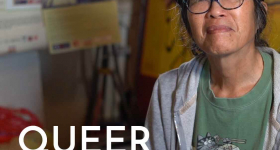Kelly Loy Gilbert’s Picture Us In the Light follows Daniel Cheng, filial son and aspiring artist, but also gay Asian American teen as he tries to survive the last nine months of his high school career. Illustrative of the experiences that many high school seniors face, Daniel’s senior year is full of change, “anniversaries,” proclamations of love and mystery. The author manages to incorporate everything from LGBTQ+ to struggles with racial/ethnic identity to the culture gap between immigrant parents and their American-born children.
Daniel is both an outsider and an insider in his Silicon Valley community, a fictional version of Cupertino, CA. Introverted and hypersensitive, he notes the small changes in other individuals. The novel opens in what appears to be Daniel’s final, uneventful month in high school, but then mysteries surface — the main one being the secrets that Daniel’s parents are keeping from him. Throughout his childhood, a ghost in the form of a long-lost sister haunts him, a remnant from his parent’s unknown life in China. In his adolescence, she begins to haunt him once more to the point where he is forced to confront her. Suicide, love and confusion ensue and fill out the narrative.
These final months of high school bring Daniel so much change that he becomes confused about what he wants out of life. As it is apparent from the first chapter, Daniel is a well-adjusted kid whose parents care for him and just want him to be happy, which is a type of family dynamic that is rare and almost unbelievable in this fictional Cupertino. In comparison to his friends and the harsh expectations set upon them by their families, Daniel is free. However, that does not translate into a life full of happiness. He must grapple with the fact that his parents are keeping secrets from him and that if he goes to college, their lives may truly fall apart. Yet, despite all of this happening in the background of their lives, his parents keep pushing him to chase after his own dreams and to pursue happiness, an extremely Western ideal that Daniel feels he has no right to follow as the son of immigrant parents. Daniel must also grapple with his own inner demons that manifest themselves in the form of insecurity, artist’s block and imposter syndrome. He feels that he hasn’t struggled enough, that he hasn’t faced enough opposition to be a “real” artist. It is only toward the end of the novel that Daniel starts to feel capable once more.
The plot plays with our innate need to be in the know by constructing events that spiral inward toward Daniel, their focus. The final pages of the novel steer readers to figure out the truth before all is revealed. However, it can be easy to lose track of clues given throughout the book. Gilbert also manages to explore several roads that sitting on the intersection between artist-queer-ABC-teenager can create. While some, like Daniel’s sexuality, are not as thoroughly explored, it is not because it is any less important. It is simply not viewed as a problem which is refreshing in its own way. For the most part, Daniel is comfortable in his own skin. Even when dealing with racial identity, the tone used is passive which reflects the experiences that people of color face when navigating the world. Overall, the novel was both fun to read and refreshing as stereotypes manifested in different ways.
Kelly Loy Gilbert is a local Bay Area author with two books under her belt and a third one on the way. As an author, Gilbert is interested is creating people, not simply characters. Her books portray lives, not mere stories or tales. She wants her readers to be able to relate in the most authentic way possible. Despite claiming to dislike coming up with plots, she still creates beautiful books that make it seem like she secretly adores outlining a plot, no matter how mind-numbing it may be. Gilbert believes that stories should give a voice to those who find it hard to speak or those who go ignored. Her books made me feel something akin to butterflies when reading — a feeling that is much needed in today’s world.










Comments